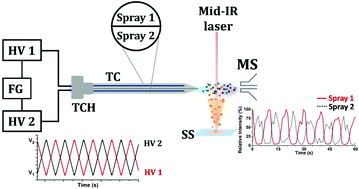Solvent gradient electrospray for laser ablation electrospray ionization mass spectrometry†
Abstract
Most electrospray based ambient ionization techniques, e.g., laser ablation electrospray ionization (LAESI), utilize a fixed spray solution composition. Complex samples often contain compounds of different polarity that exhibit a wide range of solubilities in the electrospray solvent. Thus, the fixed spray solution composition limits the molecular coverage of these approaches. Two-barrel theta glass capillaries have been used for the rapid mixing of two solutions for manipulating fast reactions including protein folding, unfolding, and charge state distributions. Here, we present a new variant of LAESI mass spectrometry (MS) by scanning the high voltages applied to the two barrels of a theta glass capillary containing two different solvents. In the resulting gradient LAESI (g-LAESI), the composition of the spray solution is ramped between the two solvents in the barrels to facilitate the detection of compounds of diverse polarity and solubility. Dynamic ranges and limits of detection achieved for g-LAESI-MS were comparable to conventional LAESI-MS. We have demonstrated simultaneous detection of different types of chemical standards, and polar and less polar compounds from Escherichia coli cell pellets using g-LAESI-MS. Varying the spray solution composition in a gradient electrospray can benefit from the enhanced solubilities of different analytes in polar and less polar solvents, ultimately improving the molecular coverage in the direct analysis of biological samples.



 Please wait while we load your content...
Please wait while we load your content...